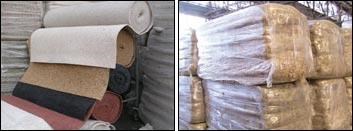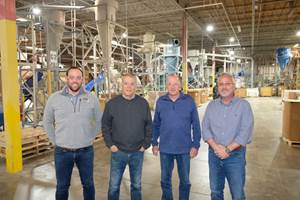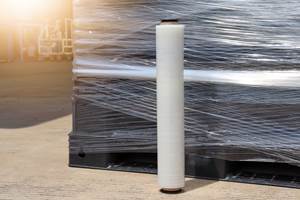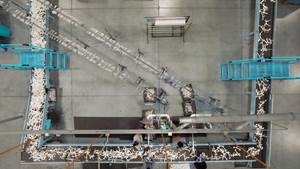Recyclers Now Targeting Higher-Value Engineered Resins
Recycling news from the Society of Plastics Engineers’ Global Plastics Environmental Conference (GPEC) in Orlando, Fla., in March focused on PET, nylon, and waste plastics in electronics—in other words, mainly on higher value engineered resins rather than commodities.Carpet recycling claimed two of the show’s big environmental awards.
Recycling news from the Society of Plastics Engineers’ Global Plastics Environmental Conference (GPEC) in Orlando, Fla., in March focused on PET, nylon, and waste plastics in electronics—in other words, mainly on higher value engineered resins rather than commodities.
Carpet recycling claimed two of the show’s big environmental awards. CARE (Carpet America Recovery Effort), the carpet industry’s four-year-old program to promote reuse of post-consumer carpet, won the Dan Eberhardt Memorial Environmental Stewardship award. But the carpet industry’s involvement in recycling didn’t start with CARE in 2002. This industry has a long history of reusing materials in its own products, and in the mid-’90s it began working with the U.S. Environmental Protection Agency and state groups in the Midwestern Work Group for Carpet Recycle. Carpet makers ended up investing hundreds of millions to build a recycling infrastructure.
In 2002 CARE set a seemingly impossible goal of 40% recovery of post-consumer carpet by the year 2012. So far the record is impressive. The industry recovered 225 million lb of post-consumer carpet in 2005, a 108% increase over 2004. The 2006 numbers will be released this month. Last year, however, about 5 billion lb of carpet went to landfills in North America, so the current recovery rate is only about 4.5%—still a long way from 40%.
But CARE’s confidence has grown with its collection volume. Cost of recycled carpet fiber—roughly 75% of which is nylon—has been reduced through use of more economical dry processes and leaving the melt-pelletizing step to the compounders and molders who reuse the fiber.
Successful applications for reclaimed carpet fiber include PP drainage chambers for in-ground septic tanks and stormwater systems made by Infiltrator Systems Inc. in Winchester, Ky. Its Champion Polymer Recycling Div. gets close to a third of the parent company’s PP raw material from post-consumer carpet. Champion melt filters and pelletizes PP fiber, then blends it with other recycled PP.
InterfaceFLOR, LLC, LaGrange, Ga., a maker of vinyl-backed carpet tiles, grinds post-consumer carpet tiles to make new carpet backing. Last year InterfaceFLOR recovered over 16 million lb and was able to recycle 84% of it.
Entec Engineered Resins, a compounder in Manchester, Tenn., has its own process for reusing nylon 66 post-consumer carpet fiber in custom compounds.
Even an early repolymerization plant for recycled nylon 6, shuttered for the past five years, is functioning again. The original Honeywell/DSM depolymerization and repolymerization plant at Evergreen Nylon Recycling in Augusta, Ga., had been hampered by low caprolactam prices and process inefficiencies. Evergreen now belongs to carpet giant Shaw Industries of Dalton, Ga., which restarted the recycling plant in February. DSM operates the plant for Shaw and has improved its efficiency. The price of caprolactam is high today, and Shaw reuses the nylon in its own carpet, rather than selling yarn on the merchant market as Honeywell did.
Shaw’s more robust collection system is expected to gather 100 million lb of post-consumer nylon 6 for Evergreen, plus another 200 million lb of other carpet types for other uses. All of this activity supports Evergreen’s success this time around.
Textile recycling renewed
A second big environmental award for recycled carpet went to CARE’s star performer, Los Angeles Fiber Co. in Vernon, Calif., the world’s largest carpet recycler. It reclaims close to 100 million lb/yr of post-consumer carpet. L.A. Fiber, founded in 1983, originally recycled industrial textile waste into a fiber product known as cotton shoddy. But with the advent of NAFTA, the largest North American textile plants began to close, and L.A. Fiber was running out of raw material. Since there was no shortage of post-consumer carpet, the firm adapted its internally developed textile-fiber recycling equipment to carpet reclaiming.
L.A. Fiber now uses handheld near-infrared (NIR) detectors to separate incoming carpet by face fiber, then bales it by polymer type—nylon 66, nylon 6, PP, and everything else. Some of this is sold off in baled form. The company also processes one material at a time, often for weeks at a time, at its Vernon recycling plant. Its dry process first shreds the carpet, then separates the fibers and removes the backing. The fiber is rebaled and sold to compounders and other end users, both here and abroad. L.A. Fiber takes the remaining material—natural fibers, polyester fibers, smaller carpet fragments, and material that’s hard to identify—and produces a proprietary product called Reliance Carpet Cushion.
ID'ing flame retardants
Two companies presented new automatic flake-sortation modules at GPEC for separating undesirable electronic waste (“e-waste”) fractions, namely plastics containing brominated and chlorinated flame retardants. S+S Separation and Sorting Technology GmbH in Germany (with a new U.S. office in Lewiston, N.Y.) presented its new x-ray detector for e-scrap, called Varisort X. It identifies plastics containing brominated flame retardants, as well as PVC—the “unwants” from the e-waste stream. No more than 50 ppm of these contaminants is permissible for e-scrap plastic to be commercially usable, S+S says.
MSS Inc. in Nashville, Tenn., also just introduced a new x-ray detection module to identify plastics with brominated flame retardants. The new module is now part of MSS’s e-Sort automatic sorting system for electronics scrap. MSS considers using x-rays to identify PVC to be problematic: “A thin piece of PVC will look like a thick piece of ABS to the x-ray,” says a company official.
Powdertech International distributes handheld and automated resin ID devices from IoSys in Ratingen, Germany. Handheld model SSS3-FR and benchtop models Slidespec-S2 and mlRoSpark can identify halogenated flame retardants. But the lab models, Slidespec and mlRoSpark, also identify polymer types and heavy-metal additives. The sIRoLine model for automated sorting lines uses NIR to identify polymers, including PVC and textiles.
Micro-foaming PET film
MicroGreen Polymers and the Univ. of Washington, Seattle, presented at GPEC an unusual approach to microcellular foaming of waste PET film by saturating it with CO2 gas under high pressure (U.S. Patents 5182307 and 5684055). A roll of PET film (0.7 I.V.) is first rewound together with a porous nonwoven layer to separate the PET film layers and allow gas to penetrate into the roll. The roll is then treated with high-pressure CO2 gas in a batch-type pressure tank. Treatment time for film 0.02 in. thick is 4 to 20 hr, depending on the level of CO2 saturation desired.
The saturated film is unwound and passed through a hot-air oven for 15 to 30 sec, allowing the gas in the film to expand, but not to break through the solid surfaces of the film, which is then cooled. The result is film with a smooth skin and a uniform micro-scale (<10-micron), closed-cell foamed core and 80% to 90% overall density reduction. The treatment costs about 42¢/lb based on throughput of 20,000 lb/day, MicroGreen estimates.
The microcellular PET film can be thermoformed into trays and deep-drawn cups. Parts with 1-mm-thick walls are heat stable to 350 F and have high surface aesthetics. MicroGreen has also tested its pressurized CO2 treatment with PEN, PS, ABS, PVC, PC, acrylic, TPU, and PLA films.
Related Content
Avoid Four Common Traps In Granulation
Today, more than ever, granulation is an important step in the total production process. Our expert explains a few of the many common traps to avoid when thinking about granulators
Read MoreEvolving Opportunities for Ambitious Plastics Recycler
St. Joseph Plastics grew from a simple grinding operation and now pursues growing markets in recycled PP, food-grade recycled materials, and customized post-industrial and post-consumer compounds.
Read MoreRevolution Develops Innovative Approach to Recycling Stretch Film
The company’s approach includes collection, cleaning and recycling of stretch film.
Read MoreReversing Logistics for Plastic Film Recycling
Learn how Mainetti built a circular supply chain for clear film packaging.
Read MoreRead Next
Troubleshooting Screw and Barrel Wear in Extrusion
Extruder screws and barrels will wear over time. If you are seeing a reduction in specific rate and higher discharge temperatures, wear is the likely culprit.
Read MoreAdvanced Recycling: Beyond Pyrolysis
Consumer-product brand owners increasingly see advanced chemical recycling as a necessary complement to mechanical recycling if they are to meet ambitious goals for a circular economy in the next decade. Dozens of technology providers are developing new technologies to overcome the limitations of existing pyrolysis methods and to commercialize various alternative approaches to chemical recycling of plastics.
Read MoreProcessor Turns to AI to Help Keep Machines Humming
At captive processor McConkey, a new generation of artificial intelligence models, highlighted by ChatGPT, is helping it wade through the shortage of skilled labor and keep its production lines churning out good parts.
Read More















